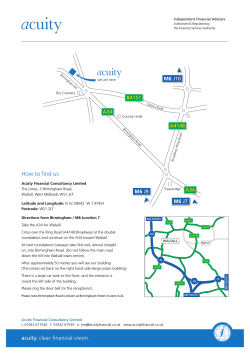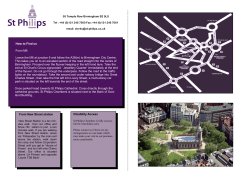
Practical ways to overcome obstacles to planning permission
A D V E R T I S E M E N T F E AT U R E l C O R N E R S T O N E IN BIRMINGHAM Practical ways to overcome obstacles to planning permission On 9 March 2015, three members of Cornerstone Barristers held a seminar at their Birmingham office that was aimed at private sector clients. It identified some current obstacles to gaining planning permission and illustrated practical ways in which they can be overcome and gain planning permission. The seminar provided an opportunity to learn more about the 37-strong Cornerstone Planning Team operating across England and Wales from its offices in London, Birmingham and Cardiff. the planning balance. Recent cases show the importance of ensuring that the planning officer’s report is ‘bulletproof’ especially when developments attract controversy. Plan-making is an area that developers ignore at their peril. The increasing numbers of local plans coming forward for examination mean that developers and landowners promoting sites cannot ignore the need to actively and appropriately participate in the plan preparation process. This has been heightened by the recently revised planning practice guidance with regard to five-year housing land supply and the department’s clear signal that ad hoc challenges to housing land supply figures through planning application and appeals are firmly discouraged. These issues must be tackled by developers if Birmingham and London are to meet their respective objectively assessed housing need figures. Another issue of growing concern is the role of the neighbourhood plan, as recent appeal decisions have demonstrated the danger in ignoring the potential for these plans to effectively block developments from gaining planning permission. A number of important themes that have emerged already this year were discussed. In March it was announced that further reforms to the system were in the pipeline. These include improving the use of planning conditions with a proposal to reduce the time limit for fee refund on the discharge of conditions from 12 to 8 weeks and an additional requirement on planning authorities to justify the imposition of precommencement conditions. Surprisingly, a widely supported proposal that planning authorities should share draft conditions with developers was not taken forward, despite the fact that this is becoming more commonplace in practice. Other changes include a reduction in some of the EIA thresholds, which may reduce the number of projects subject Mary Cook: planning & environment Clare Parry: planning, housing, regulatory and property law “A widely supported proposal that planning authorities should share draft conditions with developers was not taken forward” The seminar began by highlighting some of the key issues that developers need to address at the outset, such as whether it is the right scheme for the right location, whether there may be issues with neighbouring developments and uses and the importance of fully 3 2 T HE PL AN N E R \ M AY 2 0 1 5 investigating access and ecological issues. One area of concern is the decision-making process, particularly with regard to the housing development and the presumption in favour. Whether the presumption applies in a particular case will affect “The courts have also had to grapple with some drafting uncertainties arising out of the National Planning Policy Framework” Martin Edwards: planning & environmental “It remains important for developers to consider carefully draft committee reports and contact the council if they have concerns about the approach taken” to EIA and consequently reduce the risk of third-party challenge. The courts have also had to grapple with some drafting uncertainties arising out of the NPPF. For example, questions over green belt policy have now been answered by the Court of Appeal in Reigate & Banstead BC v Redhill Aerodrome [2014] EWCA Civ 1386, which emphasised that there has been no substantive change to longestablished green belt policy. The significance of properly addressing the impact of development on heritage assets was underlined by the recent decision of the High Court in R (OAO Gerber) v Wiltshire County Council) [2015] EWHC 524 Admin. The introduction of the Planning Court sought to speed up the hearing of High Court challenges and to ensure that specialist judges were available for planning cases. The High Court is now hearing challenges much quicker, and it is pleasing that the recent recruitment of experienced planning practitioners to the bench will increase the number of specialist planning judges. However, there are still delays at Court of Appeal level. It remains important for developers to consider carefully draft committee reports and contact the council if they have concerns about the approach taken. Further changes are being introduced to judicial review. Most significantly, a court will not quash a decision where it is highly likely the outcome would not have been substantially different. Cornerstone Barristers: 2-3 Gray’s Inn Square London WC1R 5JH 43 Temple Row Birmingham B2 5LS One Caspian Point Pierhead Street Cardiff Bay CF10 4DQ Telephone: 020 7242 4986 Fax: 020 7405 1166 DX: LDE 316 Chancery Lane Web: www. cornerstonebarristers.com Email: clerks@ cornerstonebarristers.com M AY 2015 / T H E PL AN N E R 3 3
© Copyright 2025


















